United States Architecture, Wyoming Architecture, New Cities and Communities
Joel Solkoff’s Column – Volume II, Number 6
Architectural Column by Joel Solkoff, PA, USA
8 Jan 2015
A roundabout way of considering building a new city in Wyoming; plus
- How to save the life of a small town in Pennsylvania
- Movie review of The Fountainhead, the greatest architecture movie ever made
- Importance of architects not acting like Frank Lloyd Wright, albeit a genius, a condemnation of Wright’s arrogance. Architects today need to play well with others…
Joel’s Column Vol. II, Number 6
I begin with a very personal note. Next week, I am scheduled for surgery to determine whether I have cancer. The word “cancer” itself is frightening. It brings up mental images of hospitals. I am frightened. There is a chance the biopsy on Wednesday will turn out to be cancerous; there is a chance that it won’t. So, I am a somewhat diverted in my concentration as I write this architectural criticism column.
Joel’s good news update, August 22nd. The pathologist’s report following surgery found no cancer. Unless I am hit by a pie truck or the moral equivalent, my column will continue to report on building cities, returning to Wyoming, exploring Zaha Hadid’s plans for worker housing in Spain, Le Corbusier’s historical efforts in India, and current community planning in small towns throughout the U.S. linking issuance of building permits to accessible housing. Expect the unexpected; case in point, how high insurance rates for general aviation are limiting the ability of architects to fly from project to project in U.S. states where distances are great and infrastructure limited.
Virtual Reality
I am afraid of hospitals. One reason I am afraid is because so many hospitals in which I have been a patient were so poorly designed without the patient’s needs considered.
I would be less afraid of going into surgery if I knew the operating room had been designed in advance using virtual reality modeling. Below is a screen shot from a virtual reality model used in preparation for construction of Children’s Hospital in Hershey PA, not far from where I live.
I live in State College where Penn State is located. Penn State is the largest source of income for its Centre County and surrounding counties.
Both Penn State and Hershey have major construction taking place especially now since it is still summer. Surrounding State College and Hershey is decaying housing and severe poverty. The geographic area of misery and poverty in this state is larger than the State of New Jersey, the eleventh largest state in the U.S.
Meanwhile, Pittsburgh and Philadelphia at both ends of the state prosper.
++++
On an economic note, Hershey PA was once famous for manufacturing Hershey chocolate. Hershey chocolate is no longer manufactured in Hershey Pennsylvania. Instead, a massive medical infrastructure has replaced it. Major buildings are being added all the time. As a result, the service economy, namely hospitals and educational institutions, are the primary source of income in Pittsburgh and Philadelphia and in nearly every county in the state.
No, I did not forget. The MAIN theme of today’s column:
- Building new cities
- Preserving small towns in the U.S. and globally
- Analyzing the success of such “garden” towns surrounding urban areas such as Reston, Virginia. (Postponed for a future column; sorry.)
++++

Screen shot of a virtual reality model of a room in a hospital. Photograph by Permission of Dr. Sonali Kumar
http://www.joelsolkoff.com/chapter-5-dr-kumars-thesis-on-virtual-reality-modeling/
On Wednesday I will be wheeled into the operating room and looking at the operating room from the perspective of how an architect would design a better operating room using Revit software to design the 3-D images; then, for the final step animation by porting the images into a .gaming engine like Unity.
I strongly advocate architects use virtual reality in their offices and on their iPhones and laptops. Also architects and their clients should have ready access scheduled in advance to virtual reality immersive rooms such as the one at Penn State which Dr. John Messner created. http://www.engr.psu.edu/ae/cic/facilities/ICon/
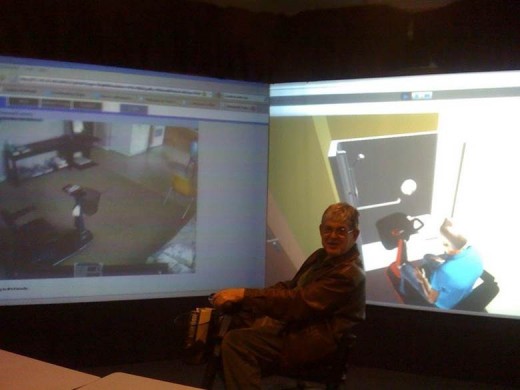
Photo of me getting ready for immersion at Dr. Messner’s virtual reality construction lab. Photo courtesy of Dr. Sonali Kumar.
On the right is a 3-D animated model. On the left is a Skype link to an actual building–constructed based on these modeling design principles.
The building itself was the Blue Roof Experimental Cottage at the other end of the state in McKeesport. The cottage was basically a detached one family, two bedroom apartment, wheel chair accessible, wide doorways, wide halls, railing everywhere to grab onto and kitchen and laundry readily accessible by wheel chair. The building was factory-built with sensors inserted at the factory. Including digging a foundation the one family house took three days to complete.
The use of inexpensive off the shelf technology is best appreciated from my perspective spending two weeks living in the cottage. I took the best shower in my twenty-years as a paraplegic. It has a roll in shower, readily-accessible grab bars, a shower-seat so designed it is easy to transfer from wheel chair to shower chair.

Photo : Joel Solkoff
The bathroom had a reassuring system that would call help if I fell in the shower.
Below is a photograph of the motion detector part of the system
The motion detector’s laser beam makes it aware that I am taking a shower because I am moving. If I fall, the motion detector is aware that I am not moving. If I do not move after a predetermined period, the detector informs the computer simulated voice to dial and talk to emergency assistance. If you were a paraplegic and fell in the shower, wouldn’t you feel more comfortable knowing help already is on the way? :
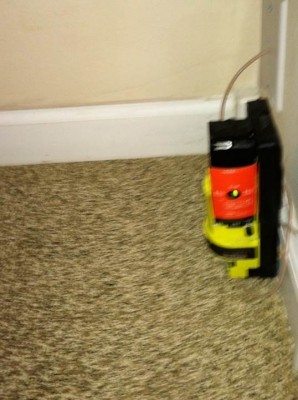
Photo : Joel Solkoff
Bathroom, Blueroof Experimental Cottage, McKeesport, PA, a dying city with high crime, an economy that forces trained young people to leave the area for jobs leaving behind a large number of elderly and disabled parents. McKeesport is a sad place that until recently served as a model for inexpensive and effective design for low-income elderly with disabilities. Funding ran out.
++++
Virtual reality modeling has two of many advantages worth mentioning.
- First, it allows the customer to make decisions about the design of major buildings.
- Second, it lowers design cost by making it easy to revise changes to a project before construction begins.
This column encourage the reader to start thing about accessible housing construction on a massive scale. A major shift in demographics is already raising alarm bells: The housing shortage is already here
++++
Now would be a good time to pause to watch a movie—a star-filled movie from Hollywood, not a virtual reality video
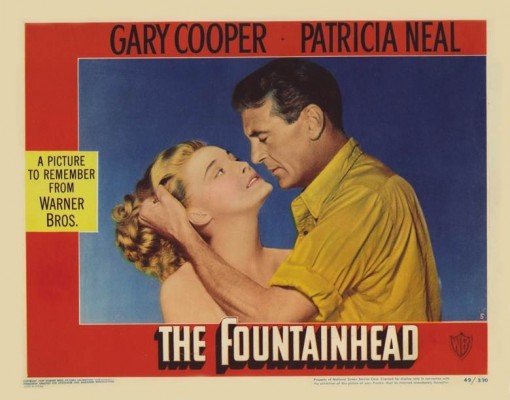
Copyright 1949 © Warner Brothers. Published under the “fair use” provisions for review purposes.
I will frequently interrupt the movie review with lengthy diversions. Be prepared for sudden switches in subject matter.
The Fountainhead Film on YouTube
Copyright © 1949. Warner Brothers. Under provisions under international copy right laws, reviewers may publish a “fair use” portion of the work. There is a perverse quality to my liking this film and despising its message. I regard the Fountainhead as the greatest movie about an architect ever made.
IMDB data base provides the following about The Fountainhead:
“An uncompromising, visionary architect struggles to maintain his integrity and individualism despite personal, professional and economic pressures to conform to popular standards.
Director:
Writers:
Ayn Rand (screenplay), Ayn Rand (novel)
Stars:
Gary Cooper, Patricia Neal, ….”
++++
In 1949 this was considered an all-star cast. Gary Cooper, hero in many Westerns and in Frank Capra movies, plays a fictional Frank Lloyd Wright.
Gary Cooper does a brilliant job of playing the role of the stereotypical arrogant architect incapable of listening to others.
When I was in elementary school, my report card would contain an evaluation question: Does Joel work well with other?The teacher would decide and tell my parents by requiring their signature on the report card.
It is important to help architects improve their image as being able to work well with others. I am sure all recipients of the Pritzker Award for Architecture know how to work well with others. The proof is in the quality, dependability and geographical diversity of their work.
It is worth noting, the majority of U.S. architects just struggle along from one project to another from offices that are undercapitalized and profit margins dangerously low.
Working well with others
When I was critiquing Renzo’s Piano Morgan Library and Museum, New York City, I was surprised by the number of superb professionals involved in making the project happen:
The first of the 4 part Piano Morgan Library video series begins with Giorgio Bianchi whom I interviewed over a live Skybox connection between State College, PA and his cubicle at Renzo Piano Building Workshop’s Paris office which has about 150 employees.
Giorgio Bianchi was Renzo Piano Workshop’s Partner in Charge of the Project. His job was to implement Renzo Piano’s Creative Plan which can be summed up in two points.
- One he built down rather than construct a skyscraper so as be sensitive to the character of the surrounding historical neighborhood.
- Second Piano emphasized the quality and quantity of billionaire J.P. Morgan art collection and designed the project focus on the vault beneath the ground where the art treasures are stored.
Frank Prial, Jr., executive architect for Beyer Blinder Belle, provided me with a behind-the-scenes tour of the Morgan where Prial helped meet regulatory standards and demonstrated his specialty of restoration.
Scott Hughes of Robert Silman Structural Engineering described management of the excavation; two-thirds of the Piano Morgan is underneath Manhattan deep into the hard schist.
President Joseph Mizzi explained the importance of construction companies being sensitive to the design goals of architects and technological advances in the building industry.
++++
BACK TO THE FOUNTAINHEAD
Consider this quote:
“He looked at the granite. To be cut, he thought, and made into walls. He looked at a tree. To be split and made into rafters. He looked at a streak of rust on the stone and thought of iron ore under the ground. To be melded and to emerge as girders against the sky. These rocks, he thought, are here for me, waiting for the drill, the dynamite, and my voice; waiting to be split, ripped, pounded, reborn, waiting for the shape my hands will give to them. “
The quote is from Ayn Rand’s 1949 novel The Fountainhead. She also wrote the screenplay. She argues intensely that The Architect must behave as an arrogant god.
What startled me was finding this quote in a twenty-first century textbook on architecture by Lee W. Waldrep. The quote appears at the beginning of Chapter I: The Definition of an Architect. Waldrep is telling his readers who want to be architects to extoll the virtues of arrogant behavior. The author, who upon publication was the Dean of the University Of Maryland School Of Architecture, should know better. It is not appropriate for today’s architects to be arrogant.
I will stop writing about the late Ayn Rand, whom a decided controversial figure with a despicable political agenda that embraces the importance of greed, selfishness, and indifference to others
It is now time to talk about Frank Lloyd Wright.
Frank Lloyd Wright
Frank Lloyd Wright was the greatest U.S. architect of the 20th century. Ada Louis Huxtable said so and I believe her. In a future column, I will explain her reasoning and that of New Yorker critic Lewis Mumford who came to the same conclusion. Until her death two years ago, Huxtable was a juror who voted for most Pritzker Prize in Architecture recipients since the prize began.
In 2004 Huxtable published a biography of Frank Lloyd Wright.
In a short engaging read, Huxtable wrote:
“[Frank Lloyd Wright] was not only an innovator, he was a hands on builder—one of the last of the master builders, in the great tradition of the art. He dictated every detail, including how the houses should be lived in, and clients would complain as much about the tyranny of his control as the unpredictability of his expense. It took a giant leap of faith to deal with the trials and terrors of unprecedented ideas, and nonapproved technology. Some found it a transformational life-enhancing experience”
THE POINT I WANT TO MAKE: When building a city of three million (or maybe considerably fewer) people in Fremont County Wyoming, it is useful to have an architect who pays attention to the client’s wishes and is not grandiose about spending without notice or authorization.
We will return to the movie in the next column because it provides the opportunity to discuss Frank Lloyd Wright’s relationship with his mentor Louis Sullivan who preached the gospel of utilitarianism and built the first skyscraper to become an art form—replacing otherwise commonplace ornamentation with simplicity.
Next step. For whom am I writing this column and what are my intentions
I am focusing this column on reaching talented global architects between the ages of 25 and 35. Further, these architects should be working at a large firm where the probability is high for achieving partner status.
I am not trying to reach partners although they are perfectly (as is everyone else) welcome to read my column over your shoulder.
My intention is to provide you with my perspective on projects related to the elderly and disabled with low- and medical-class income.
My view of that the current set of partners in large firms is that they have established formulated views and are not likely to change them although one would hope.
The stimulus for my focusing on younger architects is when a partner told me that he did not need to concern himself with disability issues because the Americans with Disability Act regulations took care of accessibility. “The architecture schools have already taught accessibility issues. That is old hat. The subject to focus on now is sustainability.”
Disability access is not resolved by simply installing ramps and doors that open automatically according to ADA regulations. Disability access requires a mindset that goes beyond a given structure and includes the entire community.
Joel’s column is focused on reaching architects who were not born in the United States and for whom English is a second language. In my four years of experience at Penn’s State’s excellent Architectural Engineering Department I have become friendly with graduate students in virtual reality, sustainability, architecture and a variety of engineering disciplines.
Foreign born students over the years have gone out of their way to ask me questions about the United States and delighted when I give long answers.
Designing a building requires more than an understanding of how to build a building. It also requires an understanding of the environment in which it is being built. I have a useful portion of that understanding regarding the United States.
I have lived in 7 U.S. cities for at least a year. I have set foot on 47 of the 50 U.S. states. I continue applying this knowledge to explain to members of the architect, engineering, and construction community how to plan for future work by describing relevant details about U.S. population, trends, economy, and politics.
I would like to receive an email from members of this targeted audience describing your interests: [email protected]
Back to Wyoming

Big Horn Canyon, Wyoming. Photo courtesy Wyoming Office of Tourism. “A landscape of sheer cliffs towering 1,000 feet above a ribbon of blue water. World class fishing and a place where wild horses still run free.”
I have been talking over the phone with Coleen Nelson President of the Wyoming American Institute of Architects.

Photograph of Colleen Nelson, President Wyoming AIA courtesy of Nelson Architects
Our conversations very from a discussion of the Debois Assisted Living Project Nelson is completing to whether there is enough room in Freemont County, Wyoming where she lives to construct a city of three million people.
The number came to mind because there are nearly three million people living in the relatively new city of Brasilia. The city has an area of 2,240 square miles 5,802 Km2.
By comparison Freemont County, Wyoming where has more than enough room on which to build a city the size of Brasilia. Freemont County has 9,266 sq. miles; 23,786 Km2; a population of 40,123. Much of the land is flat and usable. Currently, there are only 100,000 people in Freemont County.
More on building future cities to come.
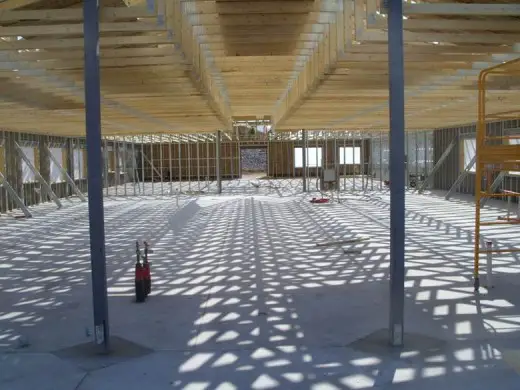
This is the basement of the assisted living facility Nelson designed which is near completion. Photo courtesy Nelson Architects.
I will conclude Wyoming for now and will return with more on Nelson’s assisted living project as well as a profile of the largest architecture firm based in Cheyenne, Wyoming’s largest city. Before continuing, I must apologize that Nelson’s photograph reproduced in the last column was not a barn, as designated, but is the roof to this very assistive living facility. Below is the roof of the Dubois Assisted Living Center.
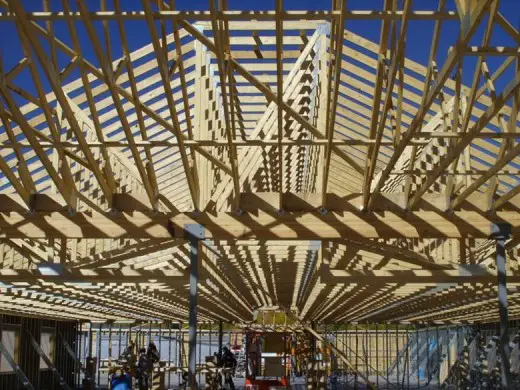
This copyrighted photograph of a barn being built is the work of architect Colleen J. Nelson, Riverton, Wyoming. It is published by permission.
Back across the U.S. we return to planning for the future of downtown State College, Pennsylvania.
In a small but important step forward, the Borough Commissioners of State College will soon be considering an ordinance requiring builders of new houses to construct residences that have wheel-chair accessible entrances, a wide door, and a first floor bathroom.
Currently, builders in the Borough can build houses without concern with accessibility issues.
To conclude: I must demote Jon Eich. The profile in the previous column referred to him as a chairman of the State college planning commission. He is not chairman. He is a member. Eich is also a member of the regional planning commission which encompasses considerable territory. Eich said about the proposed ordinance, “This ordinance proposal is an interesting idea worthy of serious consideration.”
The ordinance is modeled on one passed in Austin, Texas and will include much of the same language. The idea of constructing new homes that I cannot get into on my wheelchair makes no sense in a country where over 90 percent of housing is not wheel chair accessible.
Mayor Elizabeth Goreham is graciously helping in the effort.
Good night and good luck.
–Joel
Copyright © 2014 by Joel Solkoff. All rights reserved.
Future columns will also contain
- Discussion with Deputy Director Brian Regan of Renzo Piano’s Morgan Library and Museum on sending art to Wyoming plus the effect Renzo Piano’s new Whitney Museum of Modern Art will have on the Meat Packing District of Manhattan.
- My daughter Amelia’s quest for a photograph and perhaps even a video of Thom Mayne’s Spanish railroad station under construction near the Portuguese border,
- Influential architecture critics who changed the way the profession views itself: most notably, Patrick Geddes, Lewis Mumford, and Ada Louise Huxtable.
- Review of the wonderful and bizarre movie “The Fountainhead” in which Gary Cooper plays Frank Lloyd Wright twice as intensely as Frank Lloyd Wright played himself.
–Joel Solkoff
Copyright © 2014 by Joel Solkoff. All rights reserved.
I encourage readers to email me regarding suggestions, news, and old fashioned architectural gossip.
[email protected]
*******************
Joel Solkoff – regular guest editor at e-architect
Location: Pennsylvania
Joel Solkoff’s Column Vol.II, Number 3
Joel Solkoff’s Column Vol.II, Number 2
Joel Solkoff’s Column Vol.II, Number 1

photo : The Crescent a 1938 Art Deco hotel, Henry Hohauser architect, photo courtesy of the City of Miami Beach, Florida
Architecture in USA
Contemporary Architecture in USA
J.P. Morgan Library and Museum Building, New York City, USA

photo by Michel Denancé, provided by permission of the Morgan Library and Museum
J.P. Morgan Library and Museum Building : architecture article by Joel Solkoff. 13 Jul 2013
Comments / photos for the Pérez Art Museum Miami – Joel Solkoff’s Column Vol.II, Number 6 page welcome
